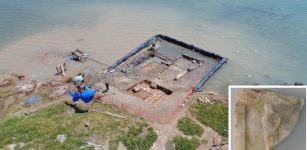What Was Life For Ancient Viking Children?
Ellen Lloyd - AncientPages.com - Like most children of the ancient world, Viking children did not have much time to enjoy their childhood. Work, learning, duties, and responsibility started at a very early age and there was not much time for playing games, but this does not mean it was boring to be a Viking child. It was simply different than it is today.
At the age of 10, ancient Viking children were considered adults and were required to follow in their parent's footsteps and acquire the necessary skills to adequately perform their mother’s or father’s job.
In ancient Norse times, the gender roles for boys and girls were quite defined. It was most common that boys worked on farms and girls did housework.
Viking children at the age of 10 were considered adults and they were required to learn the jobs and tasks that their parents did. The boys mainly worked on farms and the girls worked inside like their mothers.
Viking boys were expected to learn how to take care of themselves. This meant they must not only be good farmers, but also skilled warriors.
In order to learning farming, young boys were either working with their father, sent to a family relative, or a respected male in the ancient Viking society. There the boys learned how to plant, farm, raise livestock, and trade.
Ancient Viking children had to learn many things at an early age. Image credit: Thor News
They were also taught to fight using spears, swords, and axes. Some Viking boys, especially those of the richer families, learned to read and write the rune characters which were the Viking alphabet. Any Viking who could read and write was treated as a respected member of the Viking community.
Fighting was part of life, and just like many boys today, Viking boys also enjoyed a good fight. This was an excellent opportunity to improve one’s fighting skills and some hoped they could one day become great Viking warriors. A Viking boy caught fighting was not punished by his parents, unless he causes serious harm to his opponent.
The young Viking girl’s life was mostly focused on house duties. A Viking girl learned from her mother and grandmother how to keep run the household properly.
The girls were taught to cook, clean, prepare meals, make yarn and weave and sew. Girls were also taught farm work and tending animals as it was their duty to run a farm when the men were away.
Stronger girls were also trained in the art of war. Image credit: Thor News
Strong girls were taught sword fighting and yes, there were a few female Viking warriors. Archaeologists have discovered artifacts depicting Viking women carrying spears, swords, shields, and wearing helmets, are found on textiles and brooches, and depicted as metallic figurines, to name a few. Archaeological discoveries reveal the importance of the Valkyries. In Norse mythology, the Valkyries were the choosers of the slain.
The Valkyries were females riding on horses armed with helmets and spears. They would decide who would die in battle and drift over the battleground to find their prey.
See also:
Viking Children Were Buried With Extremely Sharp Knives – Afterlife Tools To Be Used In Valhalla?
In old Norse times, there were no formal schools for children. Viking children could learn by listening to stories told by the elders or by practicing various tasks. How much you learned depended on your own curiosity to gain knowledge in certain areas. A Vikings child’s learning was gained through real living, being a part of the community from a young age, and growing through their natural roles in it.
Viking boys and girls got married very early. Life was an experience there was no real such thing as a formal school environment. Stories might have been told by older Vikings, lessons learned in passing, and trades would be learned by time and effort, but not in a typical school environment. Involvement in Viking society was crucial.
Written by - Ellen Lloyd – AncientPages.com
Copyright © AncientPages.com All rights reserved. This material may not be published, broadcast, rewritten or redistributed in whole or part without the express written permission of AncientPages.com
More From Ancient Pages
-
 Guide To The Classics: On The Art Of Physical Exercise, A 16th Century Account Of Ancient Sports And Workouts
Featured Stories | Jul 26, 2024
Guide To The Classics: On The Art Of Physical Exercise, A 16th Century Account Of Ancient Sports And Workouts
Featured Stories | Jul 26, 2024 -
 Mystery Of The Stull Cemetery: A Gateway To Hell?
Featured Stories | Aug 25, 2018
Mystery Of The Stull Cemetery: A Gateway To Hell?
Featured Stories | Aug 25, 2018 -
 Advanced Technology Of The Ancients: Artificial Platforms Of Mighty Nan Madol
Civilizations | Sep 14, 2018
Advanced Technology Of The Ancients: Artificial Platforms Of Mighty Nan Madol
Civilizations | Sep 14, 2018 -
 Viking Children Were Buried With Extremely Sharp Knives – Afterlife Tools To Be Used In Valhalla?
Ancient History Facts | Nov 29, 2017
Viking Children Were Buried With Extremely Sharp Knives – Afterlife Tools To Be Used In Valhalla?
Ancient History Facts | Nov 29, 2017 -
 Ancient Greek Seven-Room Building And Treasures Found Underwater Off The Coast Of Salamis
Archaeology | Nov 1, 2023
Ancient Greek Seven-Room Building And Treasures Found Underwater Off The Coast Of Salamis
Archaeology | Nov 1, 2023 -
 Gigantic Karnak Temple Complex: Advanced Ancient Technology In Egypt
Civilizations | Apr 6, 2017
Gigantic Karnak Temple Complex: Advanced Ancient Technology In Egypt
Civilizations | Apr 6, 2017 -
 Men Are Slowly Losing Their Y Chromosome – Is The Future Of Humanity In Danger?
Featured Stories | Nov 7, 2023
Men Are Slowly Losing Their Y Chromosome – Is The Future Of Humanity In Danger?
Featured Stories | Nov 7, 2023 -
 ‘Vampire Of Lugnano’ And Old Beliefs In Witchcraft: Eerie And Weird Discovery In Italy
Archaeology | Oct 13, 2018
‘Vampire Of Lugnano’ And Old Beliefs In Witchcraft: Eerie And Weird Discovery In Italy
Archaeology | Oct 13, 2018 -
 Ostracism: Political Practice In Ancient Athens
Ancient History Facts | May 7, 2019
Ostracism: Political Practice In Ancient Athens
Ancient History Facts | May 7, 2019 -
 Mystery Of Acoma – Sky City Of And People Of The White Rock Reveal A Surprise
Ancient Mysteries | Aug 16, 2018
Mystery Of Acoma – Sky City Of And People Of The White Rock Reveal A Surprise
Ancient Mysteries | Aug 16, 2018 -
 Our 7-Day Week Can Be Traced To Babylonians Who Started Using It 4,000 Years Ago
Ancient History Facts | Nov 7, 2016
Our 7-Day Week Can Be Traced To Babylonians Who Started Using It 4,000 Years Ago
Ancient History Facts | Nov 7, 2016 -
 Non-Invasive Radar Will Search King Tutankhamun’s Tomb For Nefertiti’s Hidden Crypt
Civilizations | Sep 24, 2015
Non-Invasive Radar Will Search King Tutankhamun’s Tomb For Nefertiti’s Hidden Crypt
Civilizations | Sep 24, 2015 -
 Evidence Of At Least Two Lineages Of Late Neanderthals In Europe Discovered
Human Beginnings | Oct 21, 2024
Evidence Of At Least Two Lineages Of Late Neanderthals In Europe Discovered
Human Beginnings | Oct 21, 2024 -
 Ancient Secrets Of The Amazon Jungle – Dangerous Expeditions And Hidden Treasures – Part 1
Ancient Mysteries | Mar 1, 2019
Ancient Secrets Of The Amazon Jungle – Dangerous Expeditions And Hidden Treasures – Part 1
Ancient Mysteries | Mar 1, 2019 -
 Unexplained Phenomenon Around Yellowstone Puzzles Scientists
Featured Stories | Nov 12, 2018
Unexplained Phenomenon Around Yellowstone Puzzles Scientists
Featured Stories | Nov 12, 2018 -
 Carvings Of Mythological Masks Unearthed In Ancient Theater Of Stratonikeia
Archaeology | Nov 27, 2020
Carvings Of Mythological Masks Unearthed In Ancient Theater Of Stratonikeia
Archaeology | Nov 27, 2020 -
 Enchanted Ancient Egyptian Amulet Seal Discovered In Türkiye’s Amasra
Archaeology | Nov 15, 2022
Enchanted Ancient Egyptian Amulet Seal Discovered In Türkiye’s Amasra
Archaeology | Nov 15, 2022 -
 10 Ancient Fortresses Of Historical Importance
Civilizations | Jan 11, 2016
10 Ancient Fortresses Of Historical Importance
Civilizations | Jan 11, 2016 -
 Alexander The Great’s Biblical Connection
Featured Stories | May 29, 2019
Alexander The Great’s Biblical Connection
Featured Stories | May 29, 2019 -
 Merneith: Mysterious Queen In The Land Of The Pharaohs Could Be Earliest Attested Female Ruler
Featured Stories | Mar 20, 2018
Merneith: Mysterious Queen In The Land Of The Pharaohs Could Be Earliest Attested Female Ruler
Featured Stories | Mar 20, 2018




